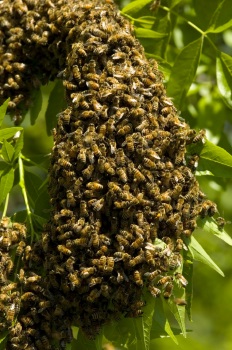 The bumble bee and honey bee are often confused because they both have very similar habits. Yet these bees are identified because of their different appearances.
The bumble bee and honey bee are often confused because they both have very similar habits. Yet these bees are identified because of their different appearances.
Biology & Reproduction
The two main species of honey bees in the U.S. are the docile European honey bee (EHB) and the far more aggressive Africanized honey bee (AHB). Honey bees live in colonies inside a hive, with a mature colony consisting of 20,000-80,000 bees. There are workers, males known as “drones,” and one queen. The entire colony will overwinter. The queen is the controlling force of the hive as she is the only one who mates and produces eggs. She can live as long as 5 years and will lay as many as 1,500 to 2,000 eggs per day. She also regulates the production of new queens and inhibits the development of workers. Young workers care for the eggs, build the comb, provide hive ventilation, and guard the hive. Older workers are foragers and gather pollen, nectar, and bee glue. They’ll live about 5 to 7 weeks during the summer, and those that survive the fall will overwinter. Drones have an even smaller life span than that. New queens will be produced and the old queen will leave with a large number of workers.
Habits
With the exception of the AHB, honey bees are nonaggressive and are more defensive than offensive. A swarm will occur when the colony becomes too large or if the queen begins to die. The swarm will move on and try to find a new residence such as another bee hives, a hollow tree, wall, attic, or another place with protection from the weather. Swarms are also typically docile because they don’t have food or young to defend. Bees that are away from the hive are less likely to sting as well unless provoked. Worker bees have stingers, thus why they are guards of the hive. When used, the stinger will detach from their body and remain in the skin until removed. The detached stinger will release a chemical that attracts other bees and alerts them to attack.
Control
Not only do honey bees provide us with honey and wax, but are of great importance because of their pollinating habits. They are so important to the environment, that they are even protected by law. However, if they invade a structure or a heavily populated area, control is warranted. While it was noted that the EHB is usually docile, the AHB is highly aggressive and dangerous. If you are in an area with a known AHB nesting site, do not approach and practice extreme caution as they will attack and can follow an intruder for 328ft. Call a professional pest control management, and do not attempt to treat or approach it yourself.
Sting Treatment
Once stung, the stinger will detach from the bee’s body and remain in the skin. Remove the stinger with something sharp like a fingernail, as muscle contractions will drive the stinger deeper into the skin and increase the rate of the toxic injection, squeezing the stinger will only release more venom. Once removed, clean the area with soap and water. A cold compress will reduce pain and swelling. Don’t rub the sting as it can spread venom and could cause an infection. If you’re stung multiple times, are feeling ill, or have a severe reaction consult a physician immediately.

